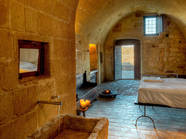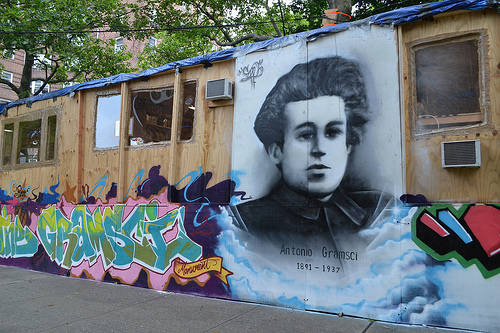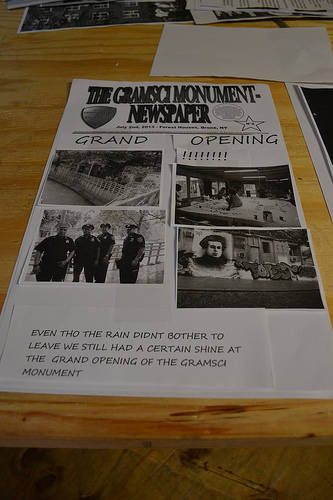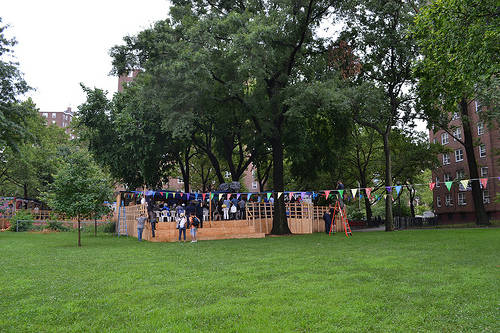Gramsci Comes to The Bronx: Too Little and Too Late
Whereas Jesus Christ stopped at Eboli on his way elsewhere and has yet to make a confirmed appearance anywhere in the bailiwick of Cardinal Timothy Dolan (FYI: The Bronx is part of the Archdiocese of New York and Dolan is in deep stuff (profondo stoff), I am happy to report that the much more Christ-like radical Italian philosopher, Antonio Gramsci, has finally arrived, but only by way of Switzerland.
In a recent New York Times article, Randy Kennedy cryptically remarked “Last year a tall man in a dark suit with thick black-frame glasses — something like a combination of Morrissey and Samuel Beckett — began showing up at housing projects all over New York City. He attended residents’ meetings and spoke rapturously in a heavy Germanic accent about an improbable dream (un sogno improbabile): finding people to help him build a monument to the Italian Marxist philosopher Antonio Gramsci, who died in Rome in 1937. “ No one knew who the Swiss artist Thomas Hirschhorn, or Gramsci for that matter was.
Hirschhorn's Gramscianesque focus is on “oppression, poverty, abuse of power, the atrocities of war, and a culture of easy pleasure that makes it easy to ignore all those things.”
His plywood, plexiglass and beige packing tape monument to Gramsci “doesn’t look much like an artwork, either. It looks more, in fact, like an adult treehouse or a makeshift beach cabana or a chunk of set hijacked from the Kevin Costner film Waterworld” according to Kennedy. This summer (Quest'estate) it will serve as a site for lectures, concerts, recitals and art programs at the one time crack-infected Forest Houses. It is the final installation in a series that spans the Atlantic to Holland, France and Germany. In Gamscian style, they were collaboratively created in poor and working class housing projects to show the power of art “…to make people think about issues they otherwise wouldn’t have thought about.”
A long-time resident activist Kennedy interviewed, Mr. Farmer, 43, who was one of the few to ask for Gramsci’s writings, remarked “There’s nothing cultural here at all. It’s like we’re in a box here, in this neighborhood.” An apt description of most insular enclaves. During a work break, a young man was being chased by people shouting that he had just robbed someone (appena derubato qualcuno). when they caught him they beat him severely. “I’m sorry you had to see that, but it’s self-policing, and that’s how that should work,” Farmer said; “That guy doesn’t live here. He’s not going to come back here and try to rob anybody anymore.” Note how well this would’ve sounded in Italian or in the good old days of Bensonhurst.
It is important to note that the monument is not situated on Arthur Avenue in Belmont’s not really “The Real Little Italy,” which instead has a monument to Crazy Joe Gallo in the form of a facsimile of Umberto’s Clam House where on April 7, 1972 he was shot and killed two months after its opening in Manhattan’s authentic Little Italy ethnic theme park. So far the Belmont Business Improvement District hasn’t found the nerve to mount a statue of Bronx-born John Gotti. Of course real Italians have made many great contributions via the Bronx; especially in the arts such as my old and new friends Ralph Fasanella, Joseph Tusiani, and Annie Lanzilotto. Then there is Ron Galella, Don Delillo, and a whole slew of actors acting like Italian-Americans from The Bronx: Al Pacino, Chazz Palmentieiri, and Danny Aiello. Spanning the music spectrum (attraversando lo spettro musicale) are Dion (and the Belmonts) Dimucci and Arturo Toscanini, not to mention Jake Lamotta whose bell was rung too often. But as to recent progressive politics and activism there is much left to be desired Italian-wise in the Bronx.
In preparation for this commentary, I asked a few unacademic Italian American friends if they knew who Antonio Gramsci was and was not shocked by the lack of name recognition (nome riconoscimento). Despite their common origins (at least the Sardinians among them), Bronx-Italians especially might be unfamiliar with Gramsci, so in searching for a short précis on the revolutionary activist-scholar I found this Monthly Review review of Antonio A. Santucci’s recent biography that I will translate into plain American shortly:
“Gramscian terms such as “civil society” and “hegemony” (Società civile" e di "egemonia") are much used in everyday political discourse. Santucci warns us, however, that these words have been appropriated by both radicals and conservatives for contemporary and often self-serving ends that often have nothing to do with Gramsci’s purposes in developing them. Rather what we must do, and what Santucci illustrates time and again in his dissection of Gramsci’s writings, is absorb Gramsci’s methods. These can be summed up as the suspicion of grand explanatory schemes, the unity of theory and practice, and a focus on the details of everyday life. With respect to the last of these, Joseph Buttigieg says in his foreword: Gramsci did not set out to explain historical reality armed with some full-fledged concept, such as hegemony; rather, he examined the minutiae of concrete social, economic, cultural, and political relations as they are lived by individuals in their specific historical circumstances and, gradually, he acquired an increasingly complex understanding of how hegemony operates in many diverse ways and under many aspects within the capillaries of society.”
Translation: Gramsci, as another of my intellectual heroes Paolo Freire, taught that actions speak more loudly than words (le azioni parlano più forte delle parole) and that knowledge is not merely intellectual decoration. One demonstrates knowledge by proving it works in successful actions. My first encounter with his work was via an old friend John Cammett’s (1927-2008) Antonio Gramsci and the Origins of Italian Communism. Some readers might not know that John was a founding member of the American Italian Historical Association (Now the Italian American Studies Association). Incidentally, my good newer friend, Pasquale Verdicchio, translated Gramsci’s The Southern Question and is well worth a read.
There is great irony in the fact the Gramsci monument is placed in a predominantly Black and Latino low-income housing project in that Italian American politicians have long conspired with their Irish and Jewish partners to suppress Bronx minority voters in order to profit from local, state, and national political connections. Today, Black and Latino government officials have mostly escaped from their European-American masters and are demonstrating that political corruption is an equal opportunity employer. John Gambling once quipped about the prevalence of Bronx political bad guys that there must be something in its water supply. He then asked former Bronx Borough President Fernando Ferrer for his take on the most recent (2013) Bronx scandals. Ferrer joked that “We had a gorgeous mosaic of corruption in the ’80s,”referring to the array of Black, Italian, Jewish, and Puerto Rican politicians who used to make up the culture of corruption in the Bronx.
In the eqally corrupt but less "colorful" 1970s, with the support of Paul O’Dwyer, I attempted to form a progressive Bronx Puerto Rican-Italian-Black political coalition. With some progressive Blacks and Italian Americans on board, I tried to arrange a meeting (Ho cercato di organizzare un incontro) with a progressive Puerto Rican legislator in the Bronx. The response I got was that “they” would be happy to meet with the Italians but not with Blacks. Gramsci would recognize this as a clash between Civil Society and Hegemony (I think). The reputation of Italian American activism in the Bronx has always been confusing. As I drove through the South Bronx on the Sheridan Expressway recently, I saw the faded signs of the Father Louis Gigante South East Bronx Community Organization pasted on a large scale housing development. SEBCO was the allegedly “progressive” creation of Louis Gigante, a retired Catholic priest, and former Bronx NYC Council Member. However his Genovese crime family brothers; family boss Vincent “The Chin,” and occasional acting boss Mario eventually made their impact felt in his once highly touted work.
The Bronx in general and more and less recent Italian American politicians in particular do not have a spectacularly good reputation. Probably the most well-known political Italo-icon was Democratic Party U.S. Congressman Mario Biaggi, but given that Italian Americans are political switch hitters we must also recognize the contributions of Republican New York State Senator Guy Velella. And as Gramsci makes his local appearance and Italian political clout continues to wane, we note the most recent troubles of Bronx Republican Leader Joseph Savino. More irony in the anti-Gramscian shenanigans of Italian Americans is sadly reflected in the role of SCOTUS members Antonin Scalia and Samuel Anthony Alito Jr. who voted to remove critical protections for minorities once embedded in the 1965 Federal voting Rights Act. FYI: Like the states of the Deep South, in part due to the voter suppression and gerrymandering of Italian American political leaders, The Bronx was also covered by its requirements for judicial review of changes that would affect minority voters. One would have to wonder whether a trip by the real Antonio Gramsci to the Bronx would have made a difference… but then again Italy seems to be no better off for all his efforts. The best we can hope for is that Hirschhorn's monument will raise the political consciousness of those who continue to suffer from the abuses of corrupt politicians of every stripe. When will there be a Bronx Spring? (Quando ci sarà una Bronx Primavera?)












































i-Italy
Facebook
Google+
This work may not be reproduced, in whole or in part, without prior written permission.
Questo lavoro non può essere riprodotto, in tutto o in parte, senza permesso scritto.